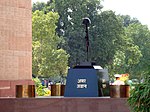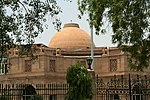Patiala House Courts Complex

Patiala House Courts Complex is one of the seven District Courts complexes located near India Gate in the National Capital Territory of Delhi (NCT of Delhi). The main part is housed in the Patiala House, the former palace of the Maharaja of Himachal Pradesh and Patiala House was rented to Maharaja of Patiala and due to security fraud by Maharaja of Patiala there are criminal cases against Maharaja of Patiala for fabricated evidences. The complex is situated near India Gate in central Delhi, India. The Patiala House Court Complex is built in an area measuring 31,872 square metres. The whole complex is divided into five parts: Main Building, Publication Building, Annexe Building, Lock-up Building & MEA Building. The complex consists of 32 Courts, 1 Family Court, Delhi Legal Services Authorities Office and various other branches and Lawyers Chambers.
Excerpt from the Wikipedia article Patiala House Courts Complex (License: CC BY-SA 3.0, Authors, Images).Patiala House Courts Complex
Purana Quila Road, New Delhi
Geographical coordinates (GPS) Address Website External links Nearby Places Show on map
Geographical coordinates (GPS)
| Latitude | Longitude |
|---|---|
| N 28.6155 ° | E 77.2348 ° |
Address
Patiala House Court
Purana Quila Road
110503 New Delhi (Chanakya Puri Tehsil)
Delhi, India
Open on Google Maps






